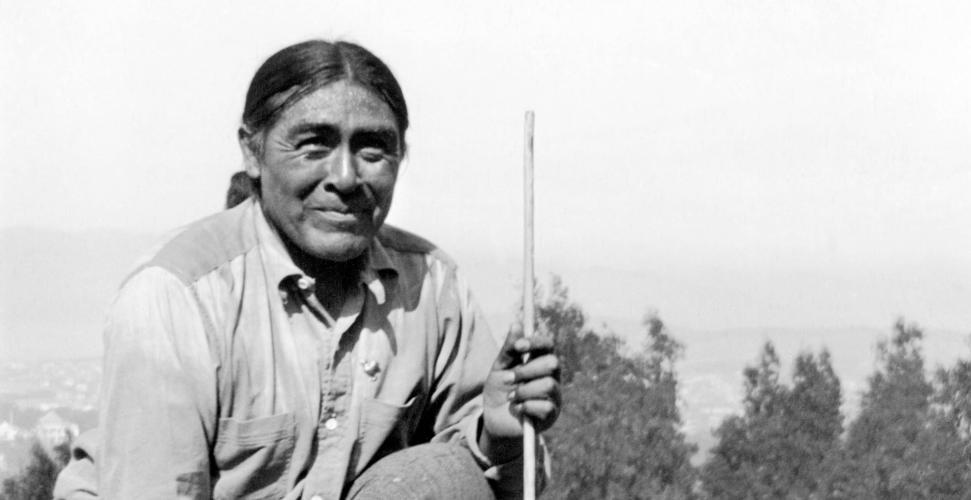In 1911 “the last wild Indian” Ishi emerged from the wilderness, the last member of his tribe

On August 29, 1911, a starving 50-year-old man walked out of the wilderness and into the town of Oroville in Northern California.
The sheriff initially put him in jail, thinking that he might have been an escapee from a mental hospital, but it would later emerge that Ishi, as he came to be known, was actually the last surviving member of his tribe, the Yahi.

Scroll down to watch the amazing documentary
He only lived for five more years after entering the town, but his short life in Western civilization came to represent how Native Americans were treated in the country as a whole.

Ishi’s life story is a tragic one. Indian Country Today explains that as gold miners and prospectors pushed deeper into the California wilderness, they often came into direct conflict with various Native American tribes, fighting with them and destroying the local resources.
They cut down too many trees, causing floods and changing the landscape, as well as decimating deer populations due to not having enough provisions.

The University of California at San Francisco lists Ishi’s year of birth at around 1860. Starting in 1865, several massacres of the Yahi people are recorded, including the Three Knolls Massacre and the Dry Camp Massacre.
By 1870, it was thought that all the Yahi had been killed, but a small band of 5-20 individuals, including Ishi, had managed to escape and spent nearly the next four decades concealed in hiding in Grizzly Bear’s Hiding Place, according to the National Parks Service.
High Country News tells of how, in 1908, surveyors chanced upon Ishi’s village while he was away. His sister and uncle fled and were never heard from again. His mother was very sick and, unable to flee, hid under a blanket until the surveyors left.
She died soon afterwards from her illness and Ishi became the last of his tribe, living in complete isolation until he emerged in Oroville three years later.

While Ishi was in jail in Oroville, two anthropologists from UC Berkeley named Alfred Kroeber and Thomas Talbot Waterman heard about him and offered that he come live at the school’s anthropology museum in San Francisco.
While he was there, Ishi taught them as much as he could about his culture and language. However, because there had not been many elders left in the small band of Yahi people that had fled after the massacres when Ishi was still young, there were gaps in his knowledge.

Furthermore, there were subjects upon which Ishi would refuse to speak, including his own name. UC Berkeley recounts that personal names were very private in Yahi culture and would very rarely have been spoken by the person to whom they belonged, and never in response to a direct question.
‘Ishi’ means ‘man’ in the Yahi language and was the name Waterman and Kroeber gave him to satisfy reporters. Yahi people also would not speak of the dead, which complicated matters given that Ishi was the last of his tribe.

Because Ishi had not been exposed to Western diseases throughout the course of his life, he had no immunity to them and was often sick. On March 25, 1916, less than five years after Ishi had entered Oroville, he died of tuberculosis.
His body was cremated and placed in the columbarium of Mount Olivet Cemetery, while his brain was preserved and later sent to the Smithsonian Institution.
People at the time were fascinated by Ishi, and he came to represent the plight of all Native Americans. Not only was he the last of his tribe, but newspapers also called him ‘the last wild Indian,’ according to The Daily Californian.
Most remaining Native Americans in this period were being sent to reservations, unable to continue their traditional way of life after contact and conflict with white settlers.
Although Ishi found shelter at the museum for the rest of his life, while he was there, he was also exploited. He was put on display demonstrating his methods of bow and arrowhead making in ways that would not be permitted today.
Although he often gave arrowheads as gifts and enjoyed making them, his treatment was likened to that of an animal at a zoo.

Recognizing this, in 1999, UC Berkeley professor of medical anthropology Nancy Scheper-Hughes wrote a letter containing an apology from the anthropology department for Ishi’s treatment at the university.
She then read it aloud to Native American activists.
https://www.youtube.com/watch?v=eYAUYMRTeYg
In the same year, Ishi’s brain, which had been housed in the Smithsonian Institution since 1917, was returned to the closest relations that could be found so that it could be buried according to Native American custom.
In 2000, his ashes were also returned to his closest relations for a traditional burial.
Although Ishi’s story is fascinating, it is also tragic and representative of the treatment of Native Americans in the US as a whole. He lived for three years in complete isolation after having lost his entire tribe and every member of his family.
Then, when he rejoined the outside society, Ishi was placed on display and used a generic name for the rest of his life before dying from a painful disease. The loneliness he must have endured can only be imagined.
